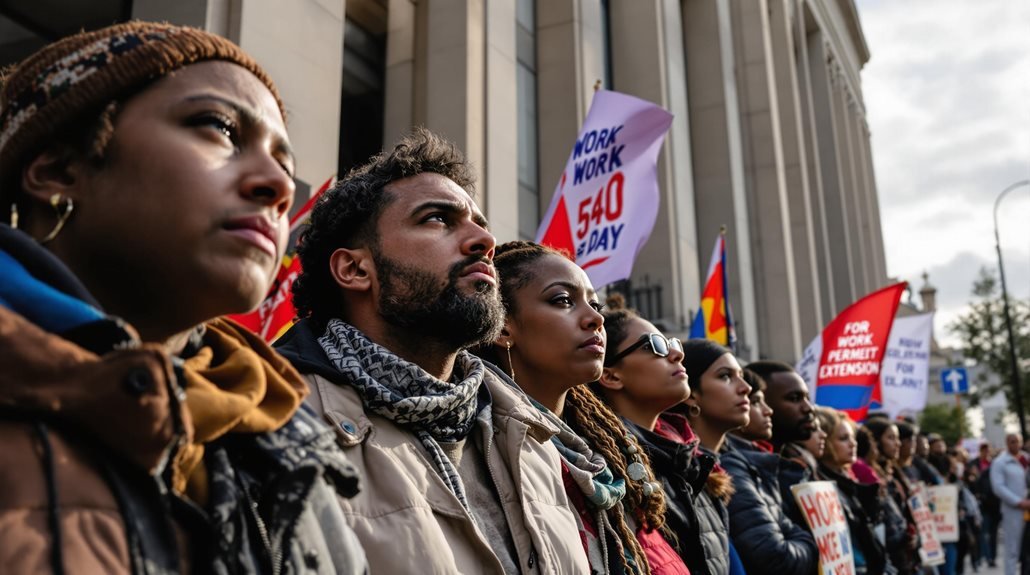The debate surrounding the 540-Day Work Permit Extension reveals significant implications for non-citizens in the U.S. Critics argue that repealing this extension may bolster immigration enforcement at the expense of the economic stability of countless workers. As the backlog of employment-based green card applications continues to grow, the potential consequences for immigrant families and the economy cannot be overlooked. What remains uncertain is how policymakers will balance these competing interests moving forward.
The Controversy Surrounding the Repeal of the 540-Day Work Permit Extension
While the Biden administration's 540-day work permit extension has been lauded for providing essential stability to non-citizens facing bureaucratic delays, the push for its repeal highlights a significant divide in American immigration policy discourse.
Critics argue that this extension undermines enforcement efforts and potentially jeopardizes border security. The political implications are profound, as calls for repeal resonate with those advocating stringent immigration measures.
Economically, repealing the extension could disrupt thousands of immigrant workers, resulting in job losses and increased financial strain on families reliant on work permits.
Consequently, this controversy underscores the tension between stability for immigrants and political enforcement priorities.
Understanding the 540-Day Work Permit Extension
The 540-Day Work Permit Extension represents a significant policy shift aimed at providing stability to non-citizens steering through the complexities of employment authorization renewals.
By extending the Employment Authorization Document (EAD) period from 180 to 540 days, this initiative seeks to mitigate employment gaps that can jeopardize immigrants' financial well-being.
The extension enhances work stability by ensuring non-citizens can maintain job security amid bureaucratic delays, thereby fostering economic contributions to the labor market.
Ultimately, this policy not only supports individual livelihoods but also strengthens the broader economy by promoting a more empowered and engaged immigrant workforce.
Eligibility Criteria for the 540-Day Auto-Extension
To qualify for the 540-Day Auto-Extension of the Employment Authorization Document (EAD), applicants must meet specific criteria that guarantee ongoing work authorization during renewal processes.
The eligibility requirements include submitting Form I-765 before the current EAD expiration and ensuring that the renewal application corresponds with the existing EAD category.
Applicants with Temporary Protected Status (TPS) can also apply.
This streamlined application process is crucial for preventing employment gaps, thereby fostering financial stability for immigrant workers.
Potential Impact of the Repeal on Immigrant Workers
How might the repeal of the 540-day work permit extension affect immigrant workers' livelihoods?
The potential repeal could trigger significant employment instability for thousands of immigrant workers reliant on these permits. Without the extension, processing delays for H-1B, H-2, and H-4 visa holders may result in sudden job losses and exacerbate financial hardships for families dependent on their income.
Such disruptions could ripple through the economy, stifling growth and decreasing overall labor productivity. The economic repercussions resonate not only within immigrant communities but also in the broader market, undermining essential sectors already facing labor shortages.
The Growing Concerns of the Immigration Backlog
Employment instability stemming from the potential repeal of the 540-day work permit extension reflects a more profound issue: the growing immigration backlog.
With over 1.8 million employment-based green card applications pending, the urgency for effective immigration reforms intensifies.
This backlog not only complicates work authorization for immigrants but also threatens their job security and the economic stability of families relying on these permits.
As businesses face disruptions amid labor shortages, the implications of an unresolved backlog extend beyond individual workers, compelling a reevaluation of policies that prioritize efficient processing to uphold the fundamental rights and freedoms of immigrant communities.
Frequently Asked Questions
What Is the Process to Apply for the 540-Day Extension?
The process for the 540-day extension involves meeting application requirements, such as submitting Form I-765 before expiration. Applicants should anticipate timeline expectations tied to processing delays, impacting work authorization stability for non-citizens awaiting renewal.
Can I Work While My Renewal Application Is Pending?
While a renewal application is pending, individuals may retain work authorization if timely submitted, ensuring continuous employment during this essential period. Maintaining application status is important to prevent employment disruptions and uphold economic stability.
How Can Employers Support Their Foreign Workers During This Period?
Employers can enhance workplace inclusion by advocating for foreign workers through transparent communication, providing resources for managing renewal processes, and actively supporting policies that protect employment rights, ultimately fostering a more equitable and resilient work environment.
What Happens if My Work Permit Expires Before the Decision?
If a work permit expires before a decision, individuals face significant work permit implications, risking employment gaps. Such disruptions not only affect personal livelihoods but also can have broader economic repercussions, impacting families and industries reliant on immigrant labor.
Are There Any Legal Resources Available for Affected Immigrants?
Legal resources are available for affected immigrants, including legal aid organizations and advocacy groups emphasizing immigrant rights. These sources provide guidance steering through complexities and support in maintaining work permits during challenging immigration policy landscapes.
